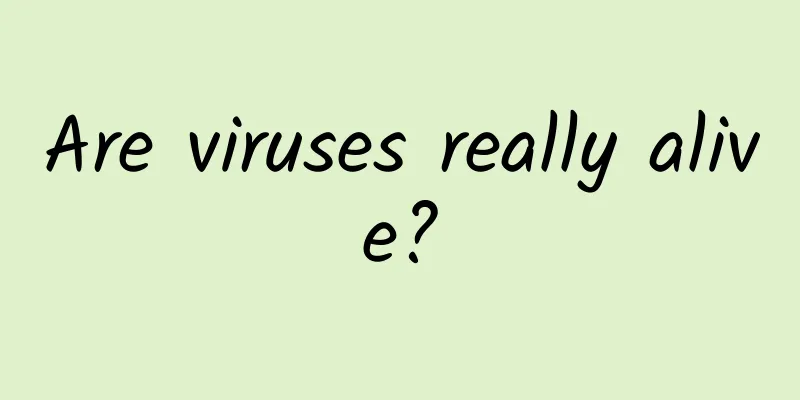Are viruses really alive?

|
© Vox Leviathan Press: From the perspective of human civilization’s short history, our knowledge of viruses can be considered a very recent thing. But even today, the debate over whether viruses are life continues. Not only that, people who know a little about viruses probably have very complicated feelings about this strange thing that is invisible to the naked eye: although most viruses are relatively friendly, there are always very deadly ones... Let me tell you something fun. The picture below is not a virus, but a bacterial flagellum. Yes, as shown in the picture, the function of the flagellum is equivalent to the propeller of a ship, which can rotate at high speed in the environment, thereby propelling the bacteria forward. If the internal structure of bacteria is magnified 50,000 times, it will be found that there is a very complex system behind its rotation, similar to the engine of a ship, with exquisite machine parts such as rotating shafts and propellers. These parts are assembled together in an orderly manner for the overall function, and each part truly plays its due functional role. This combination is not a blind random patchwork, but an exquisite micro-engineering. 40 kinds of protein molecular machines play the role of these parts. Some of these molecules obtain energy from the environment, some are responsible for sensing, and some are responsible for rotation like bearings, each with its own duties. Some people think that the operation of this entire system is obviously a highly intelligent and exquisite micro-engineering. It cannot be explained by a simple Darwinian evolution mechanism. Over the past two years, the SARS-COV2 virus, better known as COVID-19, has ravaged the world, infecting more than 346 million people and killing 5.58 million. With businesses on the brink of recovery and countries on lockdown, our lives have been completely changed. It’s humbling to think that humans are struggling to fight a pathogen that is smaller than most bacteria. And what’s even more embarrassing is that this pathogen may not even be alive. Unlike other disease-causing agents such as bacteria, protozoa, and fungi, viruses exist in a nebulous area between life and non-life, and there is much debate about which side they should be classified as. This is a fierce and long-lasting debate that raises one of the most fundamental questions in biology: What exactly is "life"? So, are viruses a form of life? Let's find out! In order to understand whether viruses are living things, we must first understand what viruses are. Viral diseases such as smallpox, rabies, polio, and influenza have been with us since the dawn of humanity, but only in recent years have scientists truly understood the specific pathogens that cause these diseases. With the development of germ theory proposed by Robert Koch, Louis Pasteur, and others in the mid-19th century, scientists began to search for and isolate the pathogen that causes every known disease. This included tobacco mosaic, a disease that stunted the growth of tobacco plants and caused their leaves to develop a mottled "mosaic" pattern. In 1892, Russian botanist Dmitri Ivanovsky ground up infected tobacco plants, filtered the juice through a ceramic filter with pores too small for bacteria to pass through, and inoculated the filtered juice onto uninfected plants. To his shock, these plants also became infected with the disease. Ivanovsky thought the disease might be caused by a chemical toxin that could pass through the filter, but he did not explore further. Martinus Beijerinck (1851-1931). © Wikimedia Commons Six years later, Dutch microbiologist Martinus Beijerinck repeated the experiment and confirmed his puzzling results. However, he took it a step further. After infecting one plant, Beijerinck crushed its leaves, filtered the juice, and continued to infect the next plant, and so on. He speculated that if the causative agent was a toxin, its effectiveness would decrease as it spread further from plant to plant, but no matter how many times he spread the disease, it did not become less effective. At first he simply thought the agent was just a surprisingly small bacterium, but no matter how hard he tried, he couldn't get it to grow in culture, the standard way to grow bacteria in the lab. It was also unaffected by alcohol, which kills nearly all known bacteria. Even stranger, the puzzling agent seemed to grow and multiply only in the presence of living cells that could divide. Since the pathogenic factor was not yet clear, Beijerinck named it "contagious living fluid", and later called it "filterable virus". The word "virus" means toxin in Latin. In the decades that followed, scientists used ceramic filters to discover more and more viruses. They discovered the foot-and-mouth disease virus that causes foot-and-mouth disease in 1898, and the yellow fever virus and rabies virus in 1932. However, the first real breakthrough in understanding the nature of viruses was made in 1935. Wendell Stanley (1904-1971) believed that the tobacco mosaic virus was a granular substance composed entirely of protein. © Sutori At the time, American chemist Wendell Stanley believed that the tobacco mosaic virus was a granular substance composed entirely of protein, rather than the liquid that Beijerinck had hypothesized. Stanley even managed to purify the virus particles into needle-shaped crystals, which could be stored in the laboratory for a long time without affecting the infection effect. As reported in the New York Times in 1940, the discovery caused a sensation in the scientific community: "Dr. Wendell Stanley of the Rockefeller Institute for Medical Research has crystallized the tobacco mosaic virus, and it has set biologists ablaze. And rightly so. Are these crystals alive? Clearly no more special than diamonds, glass, sand, or any other crystal we are familiar with, and yet when these virus crystals are placed on tobacco leaves, mosaic disease spreads like a spark that spreads across a prairie fire, just as if infected by a living bacterium." Stanley's discovery, for which he won the 1946 Nobel Prize in Chemistry, seemed to spell the end for the centuries-old theory of vitalism, which held that organisms contained some vital essence or "divine light" that gave rise to life. In contrast, the chemical hypothesis of life held that life was simply a chemical process, and Stanley's discovery that apparently inert protein particles could reproduce and spread like living things seemed to confirm this hypothesis. © PLOS However, there are still many unsolved mysteries. In the same year that Stanley made his discovery, the invention of the electron microscope allowed viruses to be observed visually by humans for the first time, and also revealed why microbiologists had not discovered them for so long. The diameter of most virus particles is about 100 nm, which is 1/100 to 1/10 of the diameter of bacteria, making it difficult to observe through ordinary optical microscopes. But this does not explain why an ordinary protein particle, although it has vitality, cannot grow under laboratory conditions. In 1926, American microbiologist Thomas Rivers proposed an explanation in a report to the American Bacteriological Society: “The virus appears to be an obligate parasite that depends on living cells for its reproduction.” In other words, viruses do not reproduce themselves through cell division like bacteria, protozoa, fungi and other microorganisms, but hijack the molecular machinery of other living cells to produce more virus particles. But how do viruses accomplish this hijacking? It turns out that the biggest piece of the puzzle was still missing. Wendell Stanley's subsequent research revealed that the tobacco mosaic virus is not just made of protein, but actually also includes ribonucleic acid, or RNA. In the 1930s and 1940s, the scientific community had a great debate about how genetic traits are passed down from generation to generation in an organism. Although the laws of heredity were discovered by Czech priest Gregor Mendel in the 1860s and refined by American biologists Thomas Hunt Morgan and Hermann Muller in the early 20th century, the specific molecules that encode and transmit specific genetic information had remained unknown. Some scientists have speculated that RNA and its cousin DNA might be the genetic material, but most believe that proteins are more likely to be the genetic material because they have a more complex structure and can store more genetic information. Viruses have played an important role in determining which hypothesis is correct. Martha Chase (left) and Alfred Hershey in 1953. © PaulingBlog/Karl Maramorosch In 1952, American bacteriologists Alfred Hershey and Martha Chase conducted a series of now-classic experiments using a virus called T2 bacteriophage that infects E. coli and was known to inject part of itself into host cells and leave the rest outside. But the question is: is the injected part nucleic acid or protein? To find out, Hershey and Chase labeled a cell culture medium with radioactive sulfur, which resulted in only the proteins in that batch of viruses being radioactively labeled. Another batch of viruses was cultured in the presence of radioactive phosphorus, which resulted in only the nucleic acid portion of that batch being labeled. Both batches of viruses were then used to infect unlabeled E. coli. The researchers centrifuged the subsequent cultures to separate the infected bacteria from the discarded noncoding portion of the virus. When the two scientists tested the radioactivity of the infected cells, they found that the bacteria in the experimental group labeled with phosphorus were radioactive, while the experimental group labeled with sulfur was not radioactive. This also confirmed that the virus injected nucleic acids rather than proteins into the bacteria. Later, scientists such as Rosalind Franklin, James Watson and Francis Crick explained the structure and function of DNA and RNA, thus starting a genetic revolution that still affects the world today. A computer simulation of the structure of the coronavirus (SARS-CoV-2). © Janet Iwasa/University of Utah Today, it is understood that all viruses consist of two basic parts: a sequence similar to DNA or RNA, and a protein coat, or capsid—or as British biologist Sir Peter Medawar put it succinctly: “(A virus) is just a piece of bad information wrapped in protein.” Viruses come in a wide variety of shapes and sizes, from porcine circoviruses, which are about 27 nm in diameter, to broad-mouthed jar viruses, which are about 1.5 μm long; from long tubular tobacco mosaic viruses to spherical coronaviruses. In addition to a protein coat, many viruses also have a lipid envelope obtained from host cells. The life cycle of a virus begins when it enters a host cell and comes into contact with its cell membrane. If a cell is susceptible to the virus, the virus attaches to its surface, injects its genetic material and some enzymes into the cell's cytoplasm like a micro-syringe, and leaves its capsid behind. Once inside a cell, the virus's genetic material begins to bar its evil fangs, hijacking the cell's metabolic machinery and transforming it from an independent organism into a small biological factory with only one purpose: to produce more virus particles. The virus accomplishes this hijacking in several different ways. Animation of how a coronavirus fuses with a cell. © Janet Iwasa/University of Utah In the case of a DNA virus, its genetic material replaces the cell's own DNA and uses the cell's own enzymes to transcribe the invading genome into messenger RNA, or mRNA. The mRNA is then read by organelles called ribosomes, which use the genetic instructions to assemble amino acids into proteins. Instead of producing the regular proteins that keep cells functioning, the ribosomes become the "initiators" of new viruses. RNA viruses, on the other hand, contain mRNA that can be read directly by the ribosomes, skipping the DNA transcription step entirely. In addition, there is a retrovirus that has more sophisticated genetic skills. Retroviruses, including HIV, contain a special enzyme, reverse transcriptase, which can integrate the viral RNA into the host cell's own DNA. This embedded viral genome is called a provirus, which can lie dormant in the host's genome for a long time, avoiding the monitoring of the immune system and spreading between cells unnoticed as cells divide and reproduce. They can also spontaneously activate, causing cells to start producing viruses again. This makes people helpless against retrovirus infections. Skin rash is a common symptom of HIV infection. © WebMD But the importance of retroviruses to humans goes far beyond the impact of the diseases they cause. In the long history of human evolution, a full 8% of human genes were acquired from protoviruses. Obviously, these genetic hitchhikers have had an important and non-negligible impact on the development of life on Earth. (www.ncbi.nlm.nih.gov/pmc/articles/PMC7093845/) Once new virus particles are assembled, they must then leave the host cell. Many viruses that infect bacteria or other single-celled organisms accomplish this through a lytic cycle, a process in which the cell membrane ruptures or dissolves, the host cell dies, and a new generation of viruses is released into the environment. However, if a virus kills the cells it encounters, it will quickly lead to the death of the host and the viruses living in it, so most viruses leave the cell by exocytosis or "budding", passing through the cell membrane without destroying it. But no matter how, the final result is the same: the newly assembled virus is released into the environment, ready to infect new cells and start the process all over again. ﹡﹡﹡ Now that we know what viruses are and how they reproduce, let’s get back to the original question: Are viruses actually alive? Like many questions in biology, the answer to this question depends on how exactly we define life. Uniquely among scientists, biologists do not agree on what they actually study. At first glance, the question of whether something is alive seems pretty straightforward. Yet throughout history, even the greatest scientists and philosophers have been unable to come up with a rigorous and verifiable definition of life. The most we can agree on can be summed up as "seeing is believing." The lack of a definition did not stop biologists from doing their work, and for many years the discussion of a definition was little more than a philosophical curiosity. But as people began to explore the universe and search for life on other planets, the question of "what is life?" suddenly became important. © Baamboozle Over the years, various scientists have tried to come up with a list of unique properties that life has. Here's one from NASA: "[Living things] have the ability to take energy from their environment and convert it into energy for their own growth and reproduction. Living things tend toward homeostasis: a balance between the many elements that define their internal environment. Living things are able to respond to stimuli by producing actions similar to reactions, such as retraction, or even more advanced forms such as learning. Living things are reproductive, and evolution requires a certain degree of replication, due to mutations in populations and natural selection. In order to survive and thrive, living things need to first become 'consumers', exchanging biomass, creating new individuals, and excreting waste." However, many non-living systems also exhibit many of these properties. For example, crystals can spontaneously assemble into amazingly complex and ordered shapes, replicate themselves, transfer the same internal structure from one crystal to another, and even move in response to external stimuli. Similarly, a block of black stone can convert solar energy into heat and convert it into kinetic energy by heating the surrounding air, while its radioactive components can spontaneously convert nuclear energy into heat. Horta, a rock-crawling creature from Star Trek. © Tumblr The above definition becomes even more vulnerable when applied to the biological world. For example, prions are the causative agent of bovine spongiform encephalopathy (better known as mad cow disease) - they are even simpler than ordinary viruses, consisting only of a misfolded protein and do not contain any genetic material. However, prions can mutate and can be transmitted and reproduced between species - although not through genetic information, but by causing the misfolding of neighboring proteins to trigger a fatal chain reaction. Erwin Schrödinger (1887-1961). © Times Literary Supplement Austrian physicist Erwin Schrödinger, famous for his idea of putting an imaginary cat in an imaginary box, proposed a set of properties that are unique to more complex life forms. In his 1944 book What is Life?, Schrödinger wrote: "Organisms have the amazing gift of controlling their own 'flow of order', thereby preventing atoms from decaying into chaos." In other words, living things appear to violate the second law of thermodynamics, which states that in a closed system, entropy—defined variously as disorder or energy that cannot be used to do useful work—is in a state of perpetual increase. In the face of natural forces that continually tend toward disorder, organisms not only manage to maintain a high degree of internal order and complexity, but also to maintain that order over generations with little loss of fidelity. Ebola virus. © National Human Genome Research Institute Of course, living things don’t really violate the second law, because they are not closed systems. They are semi-closed systems, closed enough to maintain internal order, but open enough to ensure that any increase in order inside the body is offset by a decrease in order in the outside environment—for example, by removing excess heat (which reduces entropy inside the organism and increases entropy in the environment). However, these observations led Schrödinger to speculate that semi-closed structures are critical to the functioning of living things. More importantly, he further speculated that in order to accurately pass on their internal structure and complexity to their offspring, organisms need to construct some form of "code script" that contains the instructions for building this specific organism. Later, this prescient prediction was fulfilled less than a decade later with the confirmation of the structure and function of DNA. Herpes simplex virus type 1 (HSV-1). © Pharmaceutical Technology Following Schrödinger, British biologist John Maynard-Smith believed that the essential property of life is that it can withstand the test of Darwinian natural selection, and those genetic characteristics that can increase the ability of organisms to reproduce are preferentially selected and passed on to offspring, ensuring that species can continue to evolve over time. This concept was eventually combined with the previous definition to produce the so-called "NASA definition of life", which refers to: "Life is a self-sustaining chemical system that is adaptable to Darwinian evolution." Viruses certainly deserve the title of adaptive evolution in the definition of life—the rapid mutation of the new coronavirus into multiple variants clearly demonstrates this. But the idea that viruses are living things is controversial on the first point of the definition. Unlike other life forms, viruses cannot reproduce in the absence of other living cells. Without hijacking the molecular machinery of the host cell, viruses are just inert masses of proteins and genetic material. Therefore, Gerald Joyce of the Salk Institute believes: "Under that basic definition, the virus doesn't meet the criteria." Whether or not they can be classified as living organisms, it is clear that viruses play a vital role in the natural environment. Although it is impossible to measure precisely, biologists estimate that there are about 10^31 viruses in the world. If all viruses were connected one by one, they would stretch 200 million light years away, a staggering number - far beyond the farthest known galaxy. We can find traces of viruses in all environments on Earth, and they can infect all known organisms. Although the vast majority of viruses are relatively friendly and do not cause malignant diseases. © BioCosmos Africa Nonetheless, they have had a major impact on the evolution of life on Earth, particularly by inserting viral genes into their host’s DNA via a process called reverse transcription. Blood oranges, for example, owe their existence to a viral gene called Tcs2, which responds to cold weather and transforms into a gene called Ruby, giving the fruit its distinctive deep red hue. More closely related to us humans is an ancient gene called ERVW-1, which is responsible for the formation of a fused cell structure in the human placenta, the syncytiotrophoblast, which is essential for the transfer of nutrients to the developing embryo. We all, therefore, owe our existence to a virus that infected African apes millions of years ago. © Timo Lenzen For various reasons, some scientists believe that NASA's definition of life is too narrow and should be expanded to include marginal cases such as viruses. Patrick Forterre, a microbiologist at the Pasteur Institute in France, is one of them. He believes: "Life and life processes are just names for the complex evolved forms of matter that currently exist on our planet." Fortel believes that viruses are not just a collection of proteins and nucleic acids, but also an organism that has two different states in its life cycle: virus particles, and "virocells", which are living cells that are occupied by virus particles and transformed into more virus particles. In Fortel's theory, virocells are completely different from the host cells in their normal healthy form - "ribocells". The difference between the two is: "The dream of a normal cell is to divide to produce two cells, but the dream of a viral cell is to produce 100 or even more viral cells." So, according to Fortelle, the virus particle is to the virus cell what the seed is to the oak tree. Viruses are no different than any other parasite, all of which depend on host cells to grow and reproduce. Viruses are just more dependent. Other scientists believe that any attempt to strictly define life is futile because it would prevent us from understanding the exotic life forms that have yet to be discovered on Earth or other planets. As Carol Cleland, a philosopher of science at the University of Colorado, puts it: "Definitions only tell us what a word means through our language, but they don't tell us the nature of the world. In the case of life, scientists are interested in the nature of life rather than the meaning of the word 'life' in our language. What we really need to do is to come up with a generally applicable theory of living systems, not a precise definition of the word 'life'." Despite its myriad forms, life on Earth represents only one aspect. The key to developing a general theory of living systems is to explore other possibilities for life. I am interested in developing a strategy for searching for extraterrestrial life that allows us to push the boundaries of our Earth-centric concept of life. © Shira Inbar On the other hand, I think it is futile for scientists to work tirelessly to define "life", because this does not tell us what we really want to know - "what is life". Scientific theories about life will answer these questions in a satisfactory way, and they will work for some "marginal cases". It is of no benefit to the development of life science to include atypical "living organisms" in the category of "life" just for the pleasure of some people. As the debate rages, almost all biologists are convinced that the issue has been resolved in one way or another. What we can be sure of is that viruses, whether they are living things or not, deserve our utmost admiration and respect, given their impact on life on Earth in the past, present, and future. By Gilles Messier Translated by Pharmacist Proofreading/Yord Original article/www.todayifoundout.com/index.php/2022/06/are-viruses-actually-alive/ This article is based on the Creative Commons License (BY-NC) and is published by Pharmacist on Leviathan The article only reflects the author's views and does not necessarily represent the position of Leviathan |
>>: How unique is the Jade Dragon Fern discovered for the first time in Qinghai?
Recommend
ASUS H170 PRO GAMING motherboard review: more in line with the appetite of gamers
In the thousand-yuan motherboard market, which is...
How can we get a reliable cancer screening that can cost thousands of dollars?
At the end of each year, many institutions organi...
What are the ranking factors for link popularity of a specific page?
The ranking factors for link popularity of a spec...
Omnichannel Promotion | How to find an effective user interaction strategy?
With the development of technological trends, a c...
Teach you how to build social marketing from 0-1 for free!
Users' purchasing behavior has also changed f...
Recommended places to drink tea in Wuhan
Wuhan high-end tea drinking is unique and very un...
iOS 12 wish list: These are the features Apple fans want
As we all know, Apple will release iOS 12 at the ...
My knees make a "cracking" sound when I squat. Is there something wrong with my joints?
Netizen asked: I am 25 years old. When I squat an...
APP promotion: 7 ways to acquire seed users in the early stages of entrepreneurship!
When it comes to promotion, I guess the first ste...
What do you think if the next generation iPhone keeps the big bangs design?
At the beginning of last month, Apple officially ...
How to achieve user growth? 5 key points!
In the post- mobile Internet era, whether it is a...
"Personal Nutritionist" (27 video lessons)
"Personal Nutritionist" (27 video lesso...
Why do humans have hair?
I believe you have already discovered that humans...
Are you still operating by relying on content scale to build value?
After establishing a systematic content recogniti...









